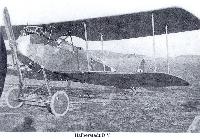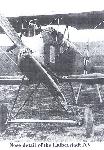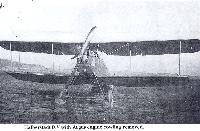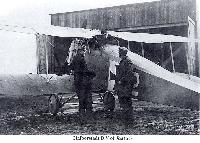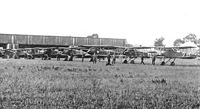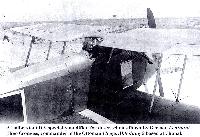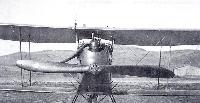
Описание
Страна: Германия
Год: 1917
Истребитель
Варианты
- Halberstadt - D.I - 1916 - Германия
- Halberstadt - D.II/D.III - 1916 - Германия
- Halberstadt - D.IV - 1916 - Германия
- Halberstadt - D.V - 1917 - Германия
- В.Кондратьев Самолеты первой мировой войны
- А.Александров, Г.Петров Крылатые пленники России
- O.Thetford, P.Gray German Aircraft of the First World War (Putnam)
- W.Green, G.Swanborough The Complete Book of Fighters
- J.Herris Halberstadt Aircraft of WWI. Volume 2: CL.IV-CLS.I & Fighters (A Centennial Perspective on Great War Airplanes 45)
-
J.Herris - Development of German Warplanes in WWI /Centennial Perspective/ (1)
Halberstadt D.V in the winter of 1916/1917. Factory camouflage is used with unit number '2'.
-
J.Herris - Halberstadt Aircraft of WWI. Volume 2: CL.IV-CLS.I & Fighters /Centennial Perspective/ (45)
Halberstadt D.V, Oblt. Hans-Joachim Buddecke, JAFU of Jasta 4, 1916. Buddecke was the 3rd ace awarded the Pour le Merite and scored 13 victories before his death in combat on 10 March 1918.
-
J.Herris - Halberstadt Aircraft of WWI. Volume 2: CL.IV-CLS.I & Fighters /Centennial Perspective/ (45)
Halberstadt D.V 421/16 '234'. After capture, recovering with new fabric, and British markings applied for technical evaluation.
-
J.Herris - Halberstadt Aircraft of WWI. Volume 2: CL.IV-CLS.I & Fighters /Centennial Perspective/ (45)
Halberstadt D.V HK29, Lt. Emil Meinecke, 6 victories, Turkish Air Service, January 1918
-
W.Green, G.Swanborough - The Complete Book of Fighters
A Halberstadt D V of the Turkish Army Aviation force, as used in 1917-18.
-
J.Herris - Halberstadt Aircraft of WWI. Volume 2: CL.IV-CLS.I & Fighters /Centennial Perspective/ (45)
Late Halberstadt D.V with Mercedes engine. The plane has been rebuilt and given 1918 markings. The aircraft was probably used for training or communications duty. (Peter M. Grosz Collection/STDB)
-
Сайт - Pilots-and-planes /WWW/
Halberstadt D.V.
-
Сайт - Pilots-and-planes /WWW/
Halberstadt D.V fighters. The gun is to port of centerline. The circular cutout in the trailing edge of the upper wing for increased pilot visibility identifies the aircraft as D.Vs; the D.II and D.III had an angular cutout. The redesigned three-piece upper wing with redesigned cabane section gave better visibility. All these aircraft had an Argus As.II engine. (Peter M. Grosz Collection/STDB)
-
Сайт - Pilots-and-planes /WWW/
Halberstadt D.V with Argus engine cowling removed.
-
J.Herris - Halberstadt Aircraft of WWI. Volume 2: CL.IV-CLS.I & Fighters /Centennial Perspective/ (45)
Closeup view of a Halberstadt D.V shows details of its Argus As.II engine. (Peter M. Grosz Collection/STDB)
-
Сайт - Pilots-and-planes /WWW/
Halberstadt D.V '2' of Jasta 5 on the Western Front. (Peter M. Grosz Collection/STDB)
-
J.Herris - Halberstadt Aircraft of WWI. Volume 2: CL.IV-CLS.I & Fighters /Centennial Perspective/ (45)
This Halberstadt D.V with happy airmen shows the inset aileron balances of the type. (Peter M. Grosz Collection/STDB)
-
J.Herris - Halberstadt Aircraft of WWI. Volume 2: CL.IV-CLS.I & Fighters /Centennial Perspective/ (45)
Oblt. Hans Joachim Buddecke in his Halberstadt D.V while serving as commanding officer of Jasta 4 at Vaux on the Western Front. This D.V has an Argus engine. The seam between the aft fuselage fabric and forward fuselage plywood is clearly seen. In his autobiography (El Schahin) he described his unit's planes as "unsere braunen Ratten" ("our brown rats"). Buddecke was awarded the Pour le Merite on April 14, 1916 while serving in Turkey, the third ace to be so honored after Boelcke and Immelmann. After serving as CO of Jasta 4, he returned to Turkey in December 1916, returning to the Western Front in February 1918, where he was KIA on March 10. (Peter M. Grosz Collection/STDB)
-
J.Herris - Halberstadt Aircraft of WWI. Volume 2: CL.IV-CLS.I & Fighters /Centennial Perspective/ (45)
Oblt. Hans Joachim Buddecke in his Halberstadt D.V while serving as commanding officer of Jasta 4 at Vaux on the Western Front. This D.V has an Argus engine. The seam between the aft fuselage fabric and forward fuselage plywood is clearly seen. In his autobiography (El Schahin) he described his unit's planes as "unsere braunen Ratten" ("our brown rats"). Buddecke was awarded the Pour le Merite on April 14, 1916 while serving in Turkey, the third ace to be so honored after Boelcke and Immelmann. After serving as CO of Jasta 4, he returned to Turkey in December 1916, returning to the Western Front in February 1918, where he was KIA on March 10. (Peter M. Grosz Collection/STDB)
-
Сайт - Pilots-and-planes /WWW/
Oberleutnant Buddecke commander of Jasta 4, in his Halberstadt D.V at Vaux.
-
J.Herris - Halberstadt Aircraft of WWI. Volume 2: CL.IV-CLS.I & Fighters /Centennial Perspective/ (45)
Lt. Douglas Schnorr of Jasta 30 in the pilot's seat of the Halberstadt D.V "arranged" for him; the guns have been removed. One-legged Schnorr, Offizier zur Besondere Verwendung (Special Duty Officer) of Jasta 30, no longer flew combat missions, but was provided with a unarmed Halberstadt D.V to fly. (Bruno Schmaling)
-
J.Herris - Halberstadt Aircraft of WWI. Volume 2: CL.IV-CLS.I & Fighters /Centennial Perspective/ (45)
Lt. Kurt Wolff with a Halberstadt fighter of Jasta 11; although obscured by the propeller, the aileron appears to be that of a D.V. In the background is a Halberstadt D.II or D.III which can be identified by the extended ailerons.
Другие самолёты на фотографии: Halberstadt D.II/D.III - Германия - 1916
-
J.Herris - Halberstadt Aircraft of WWI. Volume 2: CL.IV-CLS.I & Fighters /Centennial Perspective/ (45)
Vzflgm. Max Winkelmann (center) and Vzfw. Heinrich Bussing look toward the camera in this picture taken at Jasta 5's Gonnelieu airfield. The Halberstadt D.V fighter in the background, designated with a 'T' on its fuselage, was flown by their CO, Hans Berr.
-
J.Herris - Halberstadt Aircraft of WWI. Volume 2: CL.IV-CLS.I & Fighters /Centennial Perspective/ (45)
Halberstadt D.V in flight. (Peter M. Grosz Collection/STDB)
-
D.Mechin - Oriental Adventures of the French Air force 1914-1918 /Aeronaut/
View of a German squadron on the Orient Front, towards a DFW C.V in the foreground, a two-seater adapted to high altitude reconnaissance. In the background, a Halberstadt D.V fighter, an aircraft on which von Eschwege won most of his 19 victories. (DR)
Другие самолёты на фотографии: DFW C.V - Германия - 1916
-
J.Herris - Halberstadt Aircraft of WWI. Volume 2: CL.IV-CLS.I & Fighters /Centennial Perspective/ (45)
The Halberstadt fighter at left with the initial 'M' (for Meier?) was Halberstadt D.II(Han) 820/16 serving with Jasta 25 in Macedonia. The serial is not visible on the Halberstadt D.V at right with initial 'L'.
Другие самолёты на фотографии: Halberstadt D.II/D.III - Германия - 1916
-
J.Herris - Halberstadt Aircraft of WWI. Volume 2: CL.IV-CLS.I & Fighters /Centennial Perspective/ (45)
The Jastaschule at Famars airfield near Valenciennes with Halberstadt fighters. At right is a D.V; the other two fighters are D.II. (Peter M. Grosz Collection/STDB)
Другие самолёты на фотографии: Halberstadt D.II/D.III - Германия - 1916
-
J.Herris - Halberstadt Aircraft of WWI. Volume 2: CL.IV-CLS.I & Fighters /Centennial Perspective/ (45)
Lineup of Halberstadt D.II, D.III, and D.V fighters at Jastaschule I. Third aircraft from the right is an Albatros D.I.
Другие самолёты на фотографии: Albatros D.I/D.II - Германия - 1916Halberstadt D.II/D.III - Германия - 1916
-
K.Delve - World War One in the Air /Crowood/
A direct follow-on from the DII, the Halberstadt DIII performed reasonably well during 1916; it served on into spring 1917 pending delivery of new single-seat scout deliveries but by then its speed of 90mph (145kph) and single Spandau were simply not adequate.
-
J.Herris - Halberstadt Aircraft of WWI. Volume 2: CL.IV-CLS.I & Fighters /Centennial Perspective/ (45)
Halberstadt D.V 421/16 (work no. 234) of Jasta 30 was brought down by anti-aircraft fire on February 15, 1917. It was powered by a 120 hp Argus As.II. The pilot, Unteroffizier Heinrich Schneider, was taken prisoner. The British assigned it captured enemy aircraft number G.12. (Peter M. Grosz Collection/STDB)
-
J.Herris - Halberstadt Aircraft of WWI. Volume 2: CL.IV-CLS.I & Fighters /Centennial Perspective/ (45)
Halberstadt D.V 421/16 being paraded through London during the Lord Mayor's Show of 1917. It had been entirely recovered and painted up with fake Iron Crosses. (Peter M. Grosz Collection/STDB)
-
J.Herris - Halberstadt Aircraft of WWI. Volume 2: CL.IV-CLS.I & Fighters /Centennial Perspective/ (45)
Halberstadt D.V 421/16 being paraded through the streets of London during the Lord Mayor's Show in November 1917. Apparently this was after it had been completely re-covered in clear-doped fabric. Its British markings were painted over with "German" ones for the parade.
-
Jane's All The World Aircraft 1919 /Jane's/
The fuselage and wings of a captured Halberstadt D.III single-seat Fighter of 1916 (120 h.p. Argus As II engine).
-
Журнал - Flight за 1917 г.
Chassis and engine housing of the Halberstadt biplane.
-
J.Herris - Halberstadt Aircraft of WWI. Volume 2: CL.IV-CLS.I & Fighters /Centennial Perspective/ (45)
Halberstadt D.V 421/16 was refurbished and test flown by the British. The work number was painted on the rudder, (Peter M. Grosz Collection/STDB)
-
O.Thetford, P.Gray - German Aircraft of the First World War /Putnam/
Halberstadt D III captured by the R.F.C. and given British roundels.
-
Журнал - Flight за 1917 г.
Three-quarter rear view of the Halberstadt biplane.
-
Журнал - Flight за 1917 г.
Side view of the Halberstadt biplane.
-
Журнал - Flight за 1917 г.
A CAPTURED HALBERSTADT BIPLANE. - Three-quarter front view.
-
O.Thetford, P.Gray - German Aircraft of the First World War /Putnam/
Halberstadt D III.
-
J.Herris - Halberstadt Aircraft of WWI. Volume 2: CL.IV-CLS.I & Fighters /Centennial Perspective/ (45)
Halberstadt D.V with Mercedes D.II engine in Turkish service. (Peter M. Grosz collection/STDB)
-
J.Herris - Halberstadt Aircraft of WWI. Volume 2: CL.IV-CLS.I & Fighters /Centennial Perspective/ (45)
This Halberstadt D.V in Turkish service and the one behind both have Mercedes engines. (Peter M. Grosz Collection/STDB)
-
Сайт - Pilots-and-planes /WWW/
This Halberstadt D.V in Turkey has additional radiators attached to the fuselage sides in addition to the airfoil radiator. The pilot is Oblt.d.R. Theodor Croneiss, commander of Ottoman Fl. Abt. 6 (Peter M. Grosz Collection/STDB)
-
J.Herris - Halberstadt Aircraft of WWI. Volume 2: CL.IV-CLS.I & Fighters /Centennial Perspective/ (45)
Halberstadt D.V in Turkish service with the ground personnel of Turkish FA 5. The fighter has an Argus engine and supplementary cheek-style radiators in addition to the regular airfoil radiator.
-
J.Herris - Halberstadt Aircraft of WWI. Volume 2: CL.IV-CLS.I & Fighters /Centennial Perspective/ (45)
Hans-Joachim Buddecke (wearing tropical helmet) shows a Halberstadt D.V to General Liman von Sanders (wearing Turkish Kalpak hat) sometime during Buddecke's second tour of duty in Turkey in 1917. (Tobias Weber)
-
J.Herris - Halberstadt Aircraft of WWI. Volume 2: CL.IV-CLS.I & Fighters /Centennial Perspective/ (45)
Halberstadt D.V in Turkish markings flown by German ace Lt. Emil Meinecke, who achieved six victories over the Dardanelles. Here Meinecke is shown on January 27, 1918 after a tough combat with six British fighters. The maneuverability of the Halberstadt must have been a factor in his survival. This aircraft is fitted with a Mercedes D.II instead of the Argus As.II and has a protective plate installed to protect the carburetor intake manifold from the blast effects of the machine gun or certain types of ammunition. This slightly alters the nose contours. HK29 is marked on the Turkish insignia.
-
J.Herris - Halberstadt Aircraft of WWI. Volume 2: CL.IV-CLS.I & Fighters /Centennial Perspective/ (45)
Halberstadt D.V in Turkish markings with an Argus As.II engine which did not have an overhead camshaft to operate the intake and exhaust valves. It had push rods and rocker arms instead, whose double springs could be seen and not hidden under the valve gear covers. The cowling panels are modified to cover a higher area over cylinders to provide better streamlining and altering the nose contours. This is apparent in the Argus-engined models. Ace Lt. Emil Meinecke is second from left. Some Halberstadt D.V fighters were fitted with a 120 hp Mercedes D II engine.
-
J.Herris - Halberstadt Aircraft of WWI. Volume 2: CL.IV-CLS.I & Fighters /Centennial Perspective/ (45)
Cockpit of Halberstadt D.V 421/16. The mounting for the gun on the left is visible and the RPM indicator is mounted centrally high in the pilot's line of sight. (Peter M. Grosz Collection/STDB)
-
J.Herris - Halberstadt Aircraft of WWI. Volume 2: CL.IV-CLS.I & Fighters /Centennial Perspective/ (45)
Cockpit of Halberstadt D.V 421/16. The mounting for the gun on the left is visible and the RPM indicator is mounted centrally high in the pilot's line of sight. (Peter M. Grosz Collection/STDB)
-
J.Herris - Halberstadt Aircraft of WWI. Volume 2: CL.IV-CLS.I & Fighters /Centennial Perspective/ (45)
A somewhat unsuccessful landing by Lt. Schnorr on Jasta 30's airfield. Three Halberstadt D.Vs were provided to Jasta 30 as initial equipment. They had formerly been flown by Jasta 11 who had completed turning them in on February 28, 1917 to the Armee Flugpark 6. (Bruno Schmaling)
-
J.Herris - Halberstadt Aircraft of WWI. Volume 2: CL.IV-CLS.I & Fighters /Centennial Perspective/ (45)
Halberstadt D.V crashed by Josef Jacobs while he was an instructor at Jastaschule Ia.
-
W.Green, G.Swanborough - The Complete Book of Fighters
The Halberstadt D V with Argus As II engine.
-
Журнал - Flight за 1917 г.
THE HALBERSTADT BIPLANE. - Plan, side and front elevations.
В.Кондратьев Самолеты первой мировой войны
"ХАЛЬБЕРШТАДТ" D.II/D.III/D.IV / HALBERSTADT D.II/D.III/D.IV
Последней серийной модификацией стал "Хальберштадт" D.V, появившийся вначале 1917 г. Помимо фирмы-разработчика, его выпускали по лицензии авиазаводы "Авиатик" и "Ханновериш Вагонфабрик". D.V отличался улучшенной аэродинамикой, усиленной конструкцией планера (фюзеляж получил фанерную обшивку) и элеронами с роговой аэродинамической компенсацией. Двигатель - "Мерседес" D-II или "Аргус" As-II.
Выпуск "хальберштадтов" продолжался до весны 1917 года, после чего их сняли с производства из-за того, что по своим летным характеристикам они значительно уступали "альбатросам". Всего построено 96 экземпляров D.II, 54 D.III и 90 D.V. 33 "пятерки" в том же году были переданы Турции. Также турки получили несколько экземпляров D.II.
ДВИГАТЕЛЬ: "Аргус" As II
ВООРУЖЕНИЕ: 1 или 2 7,92-мм синхронных пулемета MG "Шпандау" 08/15
ЛЕТНО-ТЕХНИЧЕСКИЕ ХАРАКТЕРИСТИКИ
Размах, м 8,80
Длина, м, 7,30
Площадь крыла, кв.м 23,80
Сухой вес, кг 561
Взлетный вес, кг 771
Скорость максимальная, км/ч 145
Время подъема на высоту
1000 м, мин.сек 4,00
Потолок, м ?
Описание:








